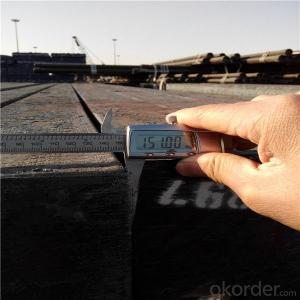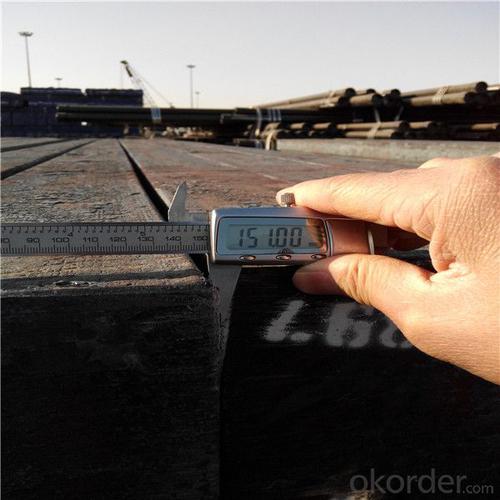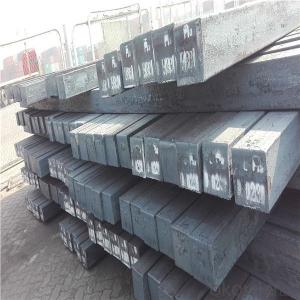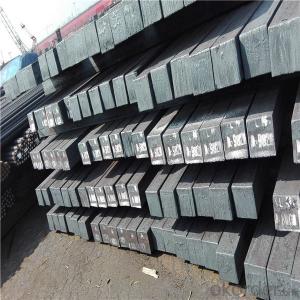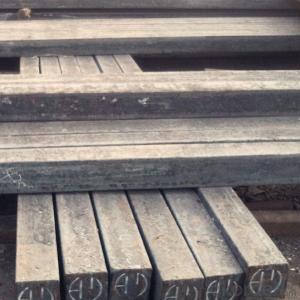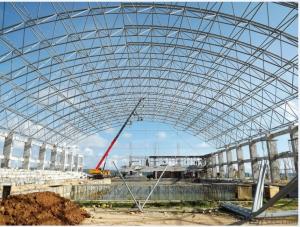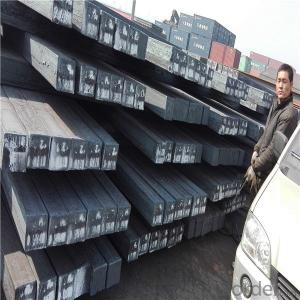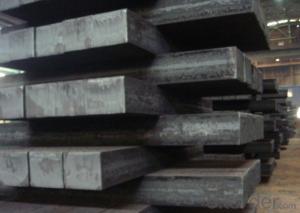150X150 square steel billets low carbon
- Loading Port:
- China main port
- Payment Terms:
- TT OR LC
- Min Order Qty:
- 1000 m.t.
- Supply Capability:
- 14263 m.t./month
OKorder Service Pledge
OKorder Financial Service
You Might Also Like
Specification
Billet:
Used for the plant, the bridge,shipment building high rise building construction,lifting and transportation machinery, equipment manufracturing base building
the support foundation pile manufacturing.
Billets, or ingots (as they sometimes referred to), are not of practical use until they have been formed
into more functional shapes and sizes. While they have already been put in the furnace, they still require
a series of shaping and molding procedures such as hot and cold working, milling and cutting before they
are sold in hardware stores, or used for different applications. The unformed billets, however, can be used
in striking currency such as coins and as reserves, similar to gold bars.
Gade:
Standard | C(%) | Mn(%) | S(%) | P(%) | Si(%) |
Q195 | ≤0.12 | ≤0.50 | ≤0.040 | ≤0.035 | ≤0.30 |
Q235 | ≤0.20 | ≤1.40 | ≤0.045 | ≤0.045 | ≤0.35 |
Q275 | ≤0.22 | ≤1.50 | ≤0.045 | ≤0.045 | ≤0.35 |
20MnSi | 0.17-0.25 | 1.2-1.6 | ≤ 0.050 | ≤ 0.050 | 0.40-0.80 |
3SP | 0.14-0.22 | 0.40-0.85 | ≤ 0.050 | ≤ 0.040 | 0.05-0.15 |
5SP | 0.28-0.37 | 0.50-1.00 | ≤ 0.050 | ≤ 0.040 | 0.15-0.30 |
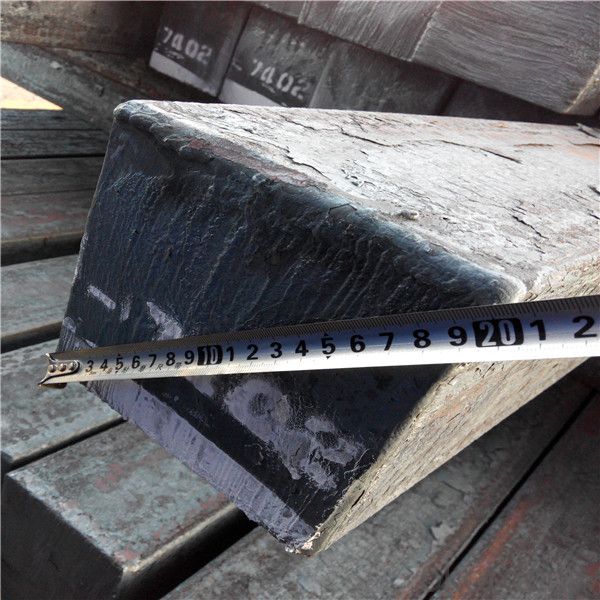
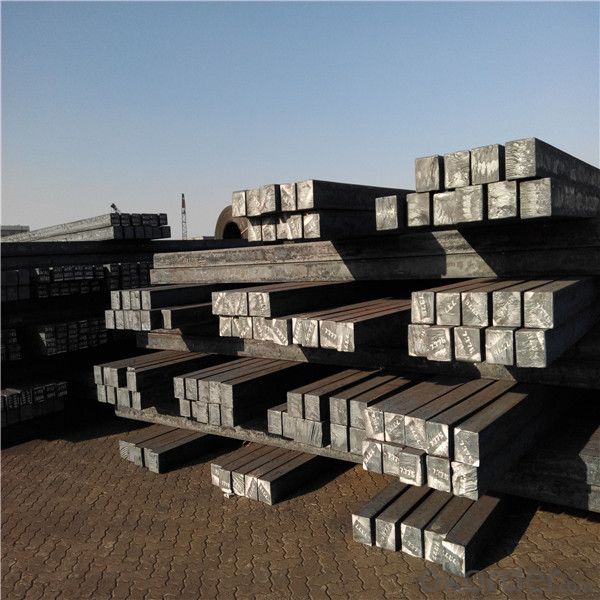
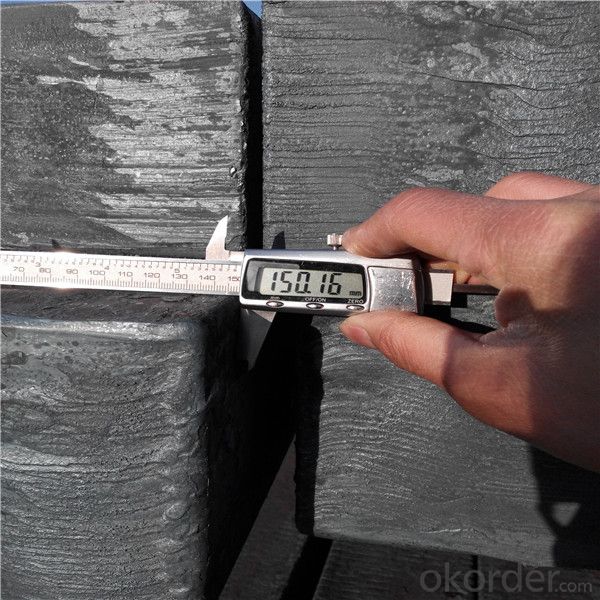

Our service :
We have a plant and professional team to provide our best service, from the start of production until the
loading into the vessel, we have a complete quality follow up procedure, to assure our products arrives to the customer with satisfaction. Welcome new and old customers
to contact us for future business relationships! We will give you a surpise price.
Packing :
Within 30 days
1.Standard export package
2.In bundles with steel strips
3.As the requirements of the customers
FAQ:
Q: What is payment terms?
A: FOB 30% T/T IN ADVANCE AS DEPOSIT AND 70% T/T BEFORE SHIPMENT
CIF and CFR 30% T/T IN ADVANCE AS DEPOSIT AND 70% T/T AS THE COPY OF B/L OR L/C AT SIGHT
Q:How to guarantee the quality of the products?
A:We have established the international advanced quality management system,every link from raw material
to final product we have strict quality test;We resolutely put an end to unqualified products flowing into the market.
At the same time, we will provide necessary follow-up service assurance.
Q:How long can we receive the product after purchase?
A :In the purchase of product within three working days, We will arrange the factory delivery as soon as possible.
The pecific time of receiving is related to the state and position of customers.
- Q: What are the main factors that determine the demand for steel billets in different industries?
- The demand for steel billets in different industries is influenced by several factors. 1. Economic conditions: The overall state of the economy plays a crucial role in determining the demand for steel billets. During periods of economic growth and increased construction activities, there is typically a higher demand for steel billets in industries such as construction, infrastructure, and manufacturing. 2. Construction and infrastructure projects: The demand for steel billets is closely tied to construction and infrastructure projects. These projects require substantial amounts of steel for various purposes, including structural support, reinforcement, and fabrication. The level of investment in construction and infrastructure projects directly affects the demand for steel billets. 3. Manufacturing activities: Steel billets are used as raw material in various manufacturing processes, including automotive, aerospace, machinery, and equipment manufacturing. The demand for steel billets in these industries is directly influenced by the level of manufacturing activities and the overall production output. 4. Technological advancements: Technological advancements and innovation can also impact the demand for steel billets. As new technologies emerge and industries evolve, the demand for steel billets may change. For example, the rise of electric vehicles has increased the demand for steel billets in the automotive industry due to the need for lightweight yet strong materials. 5. International trade and globalization: The demand for steel billets can be affected by international trade dynamics and globalization. The expansion of global supply chains and the growth of emerging economies can lead to increased demand for steel billets in different regions. Changes in trade policies or tariffs can also influence the demand for steel billets in certain industries. 6. Environmental regulations: Increasing environmental regulations and sustainability initiatives can impact the demand for steel billets. Industries that are required to reduce their carbon footprint may opt for alternative materials or adopt more efficient manufacturing processes, which could affect the demand for steel billets. 7. Price and availability: The price and availability of steel billets can significantly impact demand. Fluctuations in steel prices, supply chain disruptions, or shortages of raw materials can influence the demand for steel billets in different industries. Additionally, the availability of substitutes or alternative materials can also affect the demand for steel billets. In conclusion, the demand for steel billets in different industries is influenced by economic conditions, construction and infrastructure projects, manufacturing activities, technological advancements, international trade, environmental regulations, and price and availability factors. Understanding these factors is essential for predicting and analyzing the demand for steel billets in various industries.
- Q: Are steel billets prone to corrosion?
- Yes, steel billets are prone to corrosion. Steel is primarily made from iron, and iron is susceptible to rusting and oxidation when exposed to moisture and oxygen. Therefore, steel billets, which are the raw form of steel used for further processing, can corrode if not properly protected or maintained.
- Q: What are the different surface treatments for improved corrosion resistance in steel billets?
- Steel billets can undergo different surface treatments to enhance their resistance to corrosion. These treatments aim to establish a protective barrier on the steel's surface, preventing corrosive agents from reaching the metal beneath. Some commonly used surface treatments for improved corrosion resistance in steel billets include: 1. Hot-dip galvanizing: Immersing the steel billets in molten zinc creates a galvanized coating, which is a zinc-iron alloy. This coating offers excellent corrosion resistance and prolongs the lifespan of the steel billets. 2. Electroplating: Through electroplating, a thin layer of metal such as zinc or nickel is applied to the steel billets using an electric current. This layer acts as a protective barrier against corrosion and provides an attractive finish. 3. Powder coating: By applying a dry powder mixture of resin and pigment to the steel billets and heating it, a durable and corrosion-resistant layer is formed. Powder coating is available in various colors and finishes. 4. Paint coatings: Applying corrosion-resistant paint to steel billets creates a protective barrier that hinders moisture and corrosive agents from reaching the steel. Multiple layers of paint can be added for enhanced durability and longevity. 5. Passivation: Passivation is a chemical process that eliminates free iron and contaminants from the steel billets' surface. This process prevents corrosion and encourages the formation of a protective oxide layer. Passivation is often combined with other surface treatments like electroplating or powder coating to enhance corrosion resistance. It is important to consider factors such as the billets' operating environment, desired lifespan, and cost considerations when choosing a surface treatment for improved corrosion resistance. A thorough evaluation of specific requirements and professional consultation are crucial in determining the most suitable treatment option.
- Q: What are the specifications for steel billets used in the aerospace industry?
- The specifications for steel billets used in the aerospace industry are highly precise and stringent. These billets are required to meet specific standards in order to ensure the safety and durability of aircraft components. First and foremost, the steel used for aerospace billets must have exceptional strength and toughness. It should have a high tensile strength and be capable of withstanding extreme forces and stresses that may be encountered during flight. The steel must also have excellent fracture resistance to minimize the risk of catastrophic failure. Additionally, the steel billets must possess excellent resistance to corrosion and oxidation. This is crucial as aircraft often operate in harsh environments, including high altitudes and exposure to various chemicals. The steel should be resistant to rust, pitting, and other forms of degradation that can compromise its structural integrity over time. Furthermore, the steel billets used in aerospace applications must have precise dimensional tolerances and uniformity. The billets should be manufactured to exact specifications to ensure consistency in the production of aircraft components. This includes the size, shape, and surface finish of the billets, which are crucial for proper fitting and assembly. In terms of chemical composition, the steel used for aerospace billets may vary depending on the specific application and component being manufactured. However, it typically includes elements such as carbon, manganese, chromium, nickel, and molybdenum. These alloying elements enhance the mechanical properties of the steel, such as hardness, toughness, and heat resistance. Furthermore, the steel billets used in the aerospace industry undergo rigorous testing and quality control procedures. This includes non-destructive testing methods like ultrasonic inspection, magnetic particle inspection, and dye penetrant inspection to detect any internal defects or discontinuities. In summary, the specifications for steel billets used in the aerospace industry involve exceptional strength, toughness, corrosion resistance, dimensional accuracy, and precise chemical composition. These strict requirements ensure the reliability and safety of aircraft components, making them capable of withstanding the demanding conditions faced during flight.
- Q: What are the different methods of steel billet surface plating?
- There are several methods of steel billet surface plating, including electroplating, hot-dip galvanizing, mechanical plating, and chemical plating. Each method offers specific advantages and is used depending on the requirements of the application. Electroplating involves the deposition of a thin layer of metal onto the steel surface through an electric current. Hot-dip galvanizing immerses the steel billet into a bath of molten zinc to create a protective coating. Mechanical plating utilizes mechanical energy to bond a metal coating onto the steel surface. Chemical plating involves a chemical reaction to deposit a metal coating onto the billet surface.
- Q: What is the typical fatigue strength of a steel billet?
- The typical fatigue strength of a steel billet can vary depending on several factors such as the specific composition of the steel, the manufacturing process, and any surface treatments applied. Generally, fatigue strength refers to the ability of a material to withstand repeated loading and unloading cycles without failure. Steel, being a strong and durable material, typically exhibits a high fatigue strength compared to other materials. However, the exact value of fatigue strength can vary significantly depending on the specific grade of steel and its intended application. In engineering and industry, fatigue strength is often represented by a stress-life (S-N) curve, which plots the stress level applied to the steel billet against the number of cycles to failure. The shape of the curve provides valuable information about the fatigue behavior of the steel. It is important to note that the fatigue strength of a steel billet is usually determined through rigorous testing procedures, such as fatigue testing machines that subject the material to cyclic loading until failure occurs. These tests help engineers and manufacturers establish the safe operating limits for different steel grades and applications. Therefore, without specific information about the steel grade, manufacturing process, and any additional factors, it is not possible to provide a precise value for the typical fatigue strength of a steel billet. However, it is generally understood that steel has good fatigue resistance and can withstand a significant number of cycles before failure, making it a reliable choice for many structural and mechanical applications.
- Q: What is the role of steel billets in the manufacturing of automotive body panels?
- Steel billets play a crucial role in the manufacturing of automotive body panels as they are the starting material for the production process. These billets are heated, shaped, and formed into various body panel components, such as doors, hoods, and fenders. Their high strength and durability make them ideal for providing structural integrity and protection in automotive applications. Additionally, the malleability of steel billets allows for intricate designs and shaping, ensuring precise and smooth body panel surfaces.
- Q: What are the different types of steel billet rolling mills?
- The steel industry utilizes various types of steel billet rolling mills to shape and size heated steel bars known as billets. Some commonly used mills include: 1. Two-high rolling mills: These mills feature two rolls positioned vertically. Pressure is applied to the billet as it passes between the rolls, shaping the steel to the desired form. 2. Three-high rolling mills: These mills have three rolls, with the middle roll being larger in diameter than the top and bottom rolls. The billet is passed through these rolls, with the middle roll applying the majority of the shaping pressure. 3. Four-high rolling mills: These mills consist of two smaller rolls positioned above two larger rolls. The billet is first passed through the smaller rolls, shaping the steel, before being further refined by passing through the larger rolls. 4. Cluster rolling mills: In this type of mill, multiple rolls are arranged in a cluster. The billet is passed through these rolls, which apply pressure from various angles and directions, shaping the steel. 5. Tandem rolling mills: These mills are composed of multiple stands of rolling mills arranged in a tandem configuration. Each stand performs a specific shaping operation on the billet, and the billet is sequentially passed through each stand until the desired shape is achieved. 6. Continuous rolling mills: Designed for high-volume production, these mills operate continuously. The billet is fed into the mill without interruption, and the rolls continuously apply pressure to shape the steel as it passes through. Each type of steel billet rolling mill offers its own advantages and is suited for specific applications within the steel industry. The choice of mill depends on factors such as the desired final product shape and size, production volume, and the specific requirements of the steel being processed.
- Q: What is the difference between steel billets and steel bars?
- Steel billets and steel bars, two semi-finished products made from steel, exhibit distinct dissimilarities. To begin with, steel billets possess larger dimensions compared to steel bars. Billets typically assume a square or rectangular form with a cross-sectional area ranging from 36 to 216 square inches. Their production commonly involves the continuous casting process, which entails pouring molten steel into molds, followed by cooling and solidification. Billets function as the initial material for various steel products, including bars, rods, and wire. Conversely, steel bars display smaller proportions and adhere to more standardized shapes. Their configuration can be round, square, hexagonal, or flat, contingent upon their intended application. The production of steel bars chiefly involves the hot rolling method, wherein billets undergo heating and are subsequently passed through a series of rolling mills to achieve the desired dimensions and shape. Bars frequently find use in construction, manufacturing, and other industries that prioritize strength and durability. Another disparity between steel billets and steel bars resides in their surface finish. The casting process renders steel billets with a rough mill-scale surface. In contrast, steel bars possess a smoother surface finish, achieved through hot rolling and subsequent finishing procedures such as peeling, grinding, or polishing. Moreover, steel billets primarily serve as raw materials for further processing, while steel bars represent the final product that can be directly employed in diverse applications. Steel bars commonly feature in construction projects as reinforcement for concrete structures, in machinery and tool production, as well as in the manufacturing of automotive parts, among numerous other industrial applications. In conclusion, steel billets and steel bars differ in terms of size, shape, surface finish, and purpose. Billets are larger, rougher, and act as the starting point for various steel products, whereas bars are smaller, boast a smoother surface finish, and emerge as the final product utilized across a wide array of applications.
- Q: How are steel billets used in the production of mining equipment?
- Steel billets are an essential component in the production of mining equipment due to their strength, durability, and versatility. These billets are typically made from molten steel that is poured into a mold to form a solid rectangular shape. The resulting billets are then used as raw material in the manufacturing process of mining equipment. Mining equipment, such as excavators, bulldozers, and crushers, require robust and reliable components to withstand the harsh conditions and heavy loads experienced in mining operations. Steel billets provide the necessary structural integrity and toughness to ensure the equipment can operate efficiently and safely. Once the steel billets are obtained, they are further processed through various techniques, such as forging, machining, and welding, to transform them into specific parts and components. For example, billets can be hot or cold forged to create heavy-duty gears, shafts, and axles, which are crucial for the functioning of mining equipment. Additionally, steel billets can be machined to precise dimensions and specifications, allowing the production of custom-made components that fit seamlessly into the mining equipment. This machining process involves cutting, drilling, and milling to create parts like buckets, cutting edges, and chassis. Furthermore, steel billets can undergo welding processes to join different parts together and create complex structures. Welding ensures the integrity and strength of the equipment, as it provides a secure bond between the billets and other components. This is particularly important in the construction of mining equipment, where safety and reliability are paramount. Overall, steel billets play a vital role in the production of mining equipment by providing the necessary raw material for the manufacturing process. Their strength, durability, and versatility make them ideal for creating robust and reliable components that can withstand the demanding conditions encountered in mining operations.
Send your message to us
150X150 square steel billets low carbon
- Loading Port:
- China main port
- Payment Terms:
- TT OR LC
- Min Order Qty:
- 1000 m.t.
- Supply Capability:
- 14263 m.t./month
OKorder Service Pledge
OKorder Financial Service
Similar products
Hot products
Hot Searches
Related keywords
